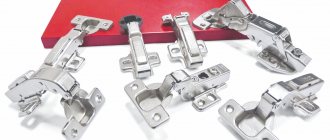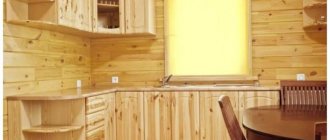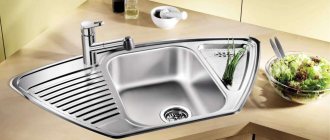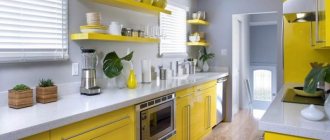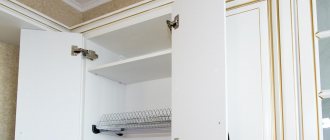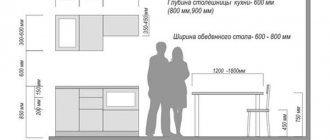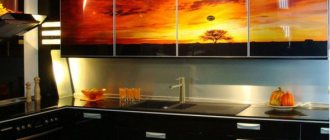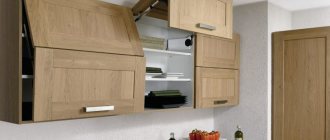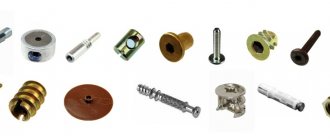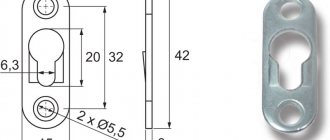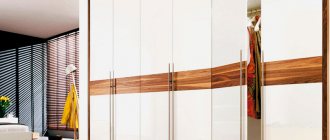Planning a kitchen space requires paying attention to every detail. The main element of attention is the bottom row of the headset.
If the top row is used to store light items that are used frequently, then the bottom row is designed to store heavy items that cause difficulty in removing them from the top shelves of wall cabinets.
This could be household appliances, large utensils, and other kitchen equipment.
The correct choice of design and dimensions of the structure will allow the headset to last a long time during its use.
How to choose kitchen furniture
Furniture in the kitchen carries not only a direct functional load, but also creates a certain mood with its appearance and colors. The optimal organization of the kitchen directly depends on what kitchen cabinets and drawers are provided in a particular set. Therefore, it is better to select a kitchen set according to the following parameters:
- sizes of cabinets and cabinets;
- the form of the entire ensemble;
- the number and location of all available built-in elements;
- quality of manufacturing materials;
- style and design.
In order to correctly calculate the size of the purchased kitchen, you need to know exactly the footage of the room, as well as the height and width of the walls along which the set is supposed to be placed.
White, brown, beige, pastel shades visually increase the space. Dilute them with contrasts to show the character of the kitchen.
The standard dimensions of kitchen furniture are as follows:
- lower modules are 60 centimeters in depth, 85 to 90 centimeters in height;
- upper modules with a depth of 30 to 35 centimeters, a height of 72 to 75 centimeters.
However, these parameters are standard, and nowadays the range of manufactured kitchen furniture is very rich. Therefore, headsets are produced with both larger and smaller parameters. If you want to purchase furniture with non-standard parameters, you need to know for sure that it will fit in the kitchen.
In terms of shape, kitchen sets are divided into three types - straight, L-shaped and U-shaped. The first type can be chosen if the furniture is purchased for a large kitchen, or for an office or guest room. The other two options fit into ordinary standard apartments without any problems.
The photo shows a beautiful kitchen interior with a set in turquoise tones.
Optimal organization of the kitchen set is possible with a work and washing table, retractable drawers, cabinets with hinged doors, and a module in which a dish dryer is installed. It is easier to determine the quantity of each module in the set, based on personal preferences, needs, as well as the parameters of the headset itself.
Differences in standard box sizes
To create optimal conditions in the kitchen, select suitable furniture. It is purchased after taking all measurements. Standard cabinet sizes vary depending on location.
Bottom furniture
Floor cabinets are considered the main part of the work area. They must be spacious and able to withstand loads.
Their standard sizes are as follows:
- total height - 85 cm;
- base height - 10 cm;
- the standard depth of lower kitchen cabinets should be at least 46 cm, for a drawer - 45 cm, for larger rooms choose deeper modules from 90 to 120 cm;
- the depth or width of the tabletop comes in three sizes: 60 cm, 90 cm and 120 cm;
- tabletop thickness - from 28 to 50 mm;
- the level of overhang of the tabletop from the front side is from 30 to 50 mm;
- level of overhang of the tabletop from the back of the cabinet - from 50 to 100 mm;
- facade width - from 30 to 90 cm, cabinets with wider facades are inconvenient to use;
- height between the internal shelves - from 20 to 40 cm (selected at the request of the user);
- The height of the pencil case is from 150 to 230 cm, the depth and width vary.
To maintain the style and functionality of the kitchen, it is recommended to follow these parameters. The height of the lower cabinets is adjusted using legs, but it is important that they look organic.
When choosing furniture, take into account the size of the tabletop. It should be no narrower than 60 cm - this is the most popular size, providing convenience when preparing food. The depth of the cabinet is 46 cm. Large countertops (from 90 cm) are suitable for spacious rooms, while the depth of the cabinet is 76 cm. A surface width of 120 cm is used in professional kitchens, or used for an island or dining table.
Pencil cases are used for built-in appliances. The standard size 60*59 cm is suitable for microwave and oven.
Upper furniture
Upper cabinets are used to store dishes, food and small household appliances. Its size and configuration are affected by its functionality:
- The height of the upper kitchen cabinets according to the standard is from 79 to 90 cm;
- The depth of the upper kitchen cabinets according to the standard is from 30 cm, it is half the depth of the lower cabinet;
- apron area - from 45 to 60 cm (depending on the user’s height);
- width of the facade - must match the width of the lower cabinet;
- height from the floor - from 180 to 250 cm.
These are the optimal sizes, they were calculated based on the average ceiling height and average human height. If the height is above average and the ceilings are high, then the furniture is placed in accordance with the necessary parameters, based on the convenience of the users.
Corner furniture
In small rooms, preference is given to corner sets, which help to rationally use space. Cabinets can be radial or pentagonal.
Before choosing, consider their standard sizes:
- total height from floor to ceiling - from 180 to 250 cm;
- depth of the upper cabinet - from 30 to 40 cm;
- depth of the lower cabinet - from 46 to 50 cm;
- facade width - from 30 to 40 cm;
- tabletop thickness - from 2 to 4 cm;
- apron size - from 45 cm;
- working surface width - from 46 cm.
The corner sections differ in format from the rest, with the lower cabinets being larger than the wall cabinets.
Floor cabinet size:
- regular or for washing, length on the sides - from 85 to 98 cm (there are options with a length of 110-130 cm);
- the width of the walls adjacent to adjacent cabinets is from 50 to 60 cm;
- The corner of the cabinet can be beveled (47 cm) and corner (56*56 cm).
For a corner pencil case measuring from 37 to 50 cm along the wall: the open side is from 17 to 25 cm, the door width is from 30 to 34 cm.
Wall cabinet:
- length on the sides - from 55 to 60 cm;
- the width of the walls adjacent to adjacent shelves is from 30 to 35 cm;
- cut width on the facade - 38 cm;
- internal cut (if available) - from 10 to 16 cm;
- internal corner - 28*28 cm, can increase depending on the depth.
Professionals recommend choosing the size of the corner structure for yourself. It should be borne in mind that the large depth of such furniture is inconvenient to use. To access the contents, the module is equipped with a roll-out basket - cargo or a rotating shelf.
Types of kitchen cabinet designs
Sets that include different types of cabinets help organize the space of the kitchen area as conveniently as possible. They come in hanging, floor, corner, and also in the form of pencil cases. Each type has both a certain functional load and design features. Each type should be examined in more detail.
Convenience during cooking and cleaning, as well as the attractiveness of the interior, directly depends on the filling of kitchen cabinets.
Wall mounted kitchen cabinets
The top row of the kitchen unit consists of wall cabinets. They are designed for storing dishes and food. Fume hoods can also be located in the top row of the kit. The design of this type of cabinet is characterized by its small size and light weight.
There are the following elements, without which not a single mounted module can be produced:
- frame;
- facade;
- internal filling.
The most popular storage element in the kitchen is a row of cabinets that are located above the work area.
According to their design features, they can be divided into closed, open and combined. Closed cabinets are equipped with shelves and doors. If the cabinet type is open, then it does not have doors. They often contain containers with spices or decorative decorations. The combined ones, accordingly, have elements of both closed and open cabinets.
The dish drying cabinet is located directly above the sink. Externally, it is no different from any closed cabinet. Inside there is a dryer for clean dishes, as well as a tray in which draining water is collected.
This is an excellent solution for small kitchens: hinged doors are not always convenient and take up more space.
Floor row of kitchen cabinets
Floor cabinets are made in the form of cabinets with one or two doors. They are placed on the bottom row of the set directly under the worktops and washing tables. Their distinctive feature from wall cabinets is their massiveness and large capacity.
Due to their functional characteristics, they are ideal for storing heavy utensils, for example:
- pots;
- frying pan;
- pots and so on.
In small kitchens, in order not to lose useful space, you want to fill every free centimeter.
Built-in household appliances are also installed in them. In addition, the floor row carries additional functionality, namely, it serves as a support for kitchen tables.
Floor elements come in the form of ordinary cabinets for storing kitchen utensils, with shelves and drawers. In addition, at the bottom of the set there is also a cabinet under the sink. In this compartment, communications are hidden from prying eyes - water and sewer pipes, water purification filters and a water meter.
The structures can be located both under the sink, where it is rational to store detergents, and under the hob.
It also houses a trash can. The interior of this department is hollow, there are no shelves or drawers, and there is no back wall.
Corner models
Corner cabinets are present in L-shaped sets. The advantage of this type of cabinets is the optimization of a small kitchen space, as well as the most rational use of a free corner. The corner cabinet is compact in size, while its capacity is greater than that of a regular cabinet.
A special design called a “locomotive” will allow you to make maximum use of the angle.
The corner cabinet can be equipped with a drawer and shelves. The model is usually produced with a hinged door. Depending on the design features, as well as the location, the cabinet can be a wall cabinet, a sink cabinet, or a pencil case.
Kitchen pencil cases
A combined version of wall and floor cabinets is a pencil case. All tiers of the kitchen set coexist perfectly in it, the capacity is very high, because the height of such a module corresponds to the height of the top row. In addition, the cabinet is solid, that is, the space in the middle is equipped with shelves, while there is free space between the upper and lower tiers of cabinets.
Each cabinet is built in a specific place to avoid inconvenience during operation.
Depending on how many sections there are in a particular cabinet, it can be single- or multi-door. The functionality of such a module can be quite diverse - if there are a large number of shelves inside, it is convenient to store a lot of products here. cutlery, or even all kitchen utensils. If the cabinet is made hollow, you can hide the refrigerator behind its facade.
Combined types of pencil cases are especially popular. In such modules, the upper and lower parts are allocated for storing food or dishes, and built-in household appliances are placed on the middle level.
A multifunctional kitchen will turn the cooking process into pleasure, and the time for cleaning will be reduced significantly.
Selection rules
To ensure that the set does not disappoint, you should approach the choice of cabinets carefully. You need to take into account not only the appearance, but also the functionality. It is recommended to adhere to certain rules:
- The height of the modules must correspond to the height of the owner, otherwise it will be inconvenient to use the cabinets.
- The smaller the distance between the countertop and the bottom of the cabinets, the more spacious the set will be.
- For small rooms, it is recommended to choose corner sets.
- Tall cabinets will help save space.
- Furniture should be made of material that is not afraid of steam and water and is easy to clean.
- A white glossy set that will reflect light will help to visually increase the area.
- It is advisable to choose the simplest possible fittings, as they are easier to clean.
Cabinets must match the interior of the room. This applies not only to the color scheme, but also to the texture. Depending on the wishes of the owners, furniture can harmonize with the design or act as an accent.
Dimensions
Spaciousness High-quality material
Simple fittings
Filling cabinets
Any of the kitchen cabinets carries a certain functional load and it depends on how correct the internal space in each of them is. Storage systems can be retractable or roll-out.
To optimize the internal space of modules, modern furniture production offers a large selection of elements that allow maximum use of the internal space of furniture.
By ordering drawers separately, you can save money and get ergonomic kitchen contents.
These include:
- Mesh baskets. These are metal meshes made in the shape of the letter P. They can be mounted both on the inside of the facade and on the side walls. Very convenient to use empty space in the cabinet under the sink;
- The carousel is rotating. There is an axis installed inside the cabinet, on which there are semicircular shelves with the possibility of rotation;
- Folding element. The set includes narrow drawers or rectangular shelves. They are fixed on rotating mechanisms. The front row is fixed on the inside of the façade. When the cabinet door opens, the entire structure unfolds in sequence;
- Bottle holders. They are characterized by high sides and a rather narrow width.
An important role when choosing a kitchen set is also played by what door opening systems it is equipped with. The systems are swing, lifting and retractable.
To install doors from cabinets and drawers in the upper position, reliable lifting mechanisms are installed.
The cabinets in the upper and lower rows use hinged doors. The mechanism in them is hinges, which can allow the door to be opened at a certain angle or completely. Some hinge models have built-in motion closers.
Lifting mechanisms are often used in wall cabinets. They are equipped with latches that allow the door to remain horizontal, as well as movement closers. The system is set to apply a slight pressure, after which the door lifts completely.
Hinged models with locks just need to be lifted, and the device will prevent the door from slamming.
Retractable opening systems use roller or ball guides. Opening can be either complete or partial.
Important parameters
To create a comfortable work area in the kitchen, the following indicators are taken into account:
- area of the room, its proportions;
- the height of the room, the height of the top row cabinets depends on it;
- number of household appliances;
- the height of the user, which determines at what height to hang the upper kitchen cabinets;
- location of communications.
Depending on these parameters, the dimensions of the kitchen unit may change:
- Height of lower furniture cabinets. The norm is 85 cm, it is designed for a person 160–170 cm tall and can be reduced or increased with the help of legs.
- Height of upper kitchen cabinets from the floor. The minimum distance to their lower edge from the table top is 45 cm. For people of average height, the optimal height of the apron is 60 cm. The bottom shelf of the top row should be at eye level of the user, and the top one should be accessible at arm's length. The upper edge of the module can reach 210–240 cm from the floor. The height of open-type hanging shelves is calculated according to the same principle.
- Width of modules. Hinged doors over 50 cm are inconvenient to open, so cabinets with dimensions of 90 cm are rarely used in sets.
- Distance from the lower kitchen cabinets to the rest of the furniture. For free movement along the working surface, 90–120 cm is enough.
When installing a kitchen set along the entire length of the wall, you must leave a gap of 10–15 cm. This is important for ease of use. For the same reason, its upper edge should not come close to the ceiling.
Kitchen cabinet fronts
The front part of any kitchen set is both a decorative element and a protective surface that allows you to preserve the furniture for many years. Therefore, when choosing a kitchen in terms of facade, it is important to pay attention to how moisture and heat resistant it is, what is the strength and reliability of the material, as well as the ability to avoid mechanical damage.
It looks interesting if one of the sides is located along the window - the tabletop on the windowsill is used as a work or dining table.
Kitchen sets are made from different materials - wood, chipboard, MDF and chipboard. In addition, manufacturers offer models in which the façade parts are made of glass. The glass facade can be decorated using photo printing, sandblasting, or simply tinted with a special coating. However, such models of kitchen cabinets are quite expensive.
Kitchen furniture made from chipboard and MDF materials is additionally covered with a special layer, which allows you to extend the service life of the set and maximally protect its modules from negative influences.
If you don’t want to lose a single centimeter, order a built-in kitchen made to measure.
The coating can be in the form of a special film or plastic. Finishing with PVC film has a number of undeniable advantages. These include moisture resistance, a wide range of colors and reliefs, affordable prices, as well as resistance to mechanical damage.
However, this type of coating also has a drawback - deformation and peeling from surfaces when exposed to high temperatures. Plastic facades also have both disadvantages and advantages.
The main thing when arranging is to preserve space and add functionality.
The advantages include moisture resistance, ease of cleaning and washing, a large selection of colors and high heat resistance. In terms of practicality in operation, plastic finishing is more profitable.
The disadvantages of this coating include low impact resistance and is not protected from some mechanical damage. For example, scratches remain when surfaces are treated with abrasive cleaning agents.
Facade and countertop materials
Kitchen cabinets should not only be beautiful, but also practical, otherwise they will have to be replaced quickly. The material used for the manufacture of facades and work surfaces must be moisture resistant, resistant to exposure to steam and high temperatures, and resistant to mechanical damage. Most often, facades are made from:
- Chipboard. Budget material with low performance properties. Such slabs can become deformed due to constant moisture and steam. Average service life is 5–7 years. The main advantage of chipboard is its availability.
- MDF. Plates of this type are more reliable, durable, and environmentally friendly. Thanks to special impregnations, they are not afraid of high temperatures and humidity.
- Natural array. Natural luxury material, which is used for the production of premium kitchen sets. Furniture with lower and upper cabinets made of wood is expensive and requires careful handling.
Additionally, facades can be covered with PVC film or acrylic. Also, doors are often decorated with mirrors. As for the working surface, it can be made of:
- laminated chipboard - the most budget option with appropriate performance characteristics;
- stainless steel - this model is durable and reliable;
- tempered glass - the coating is easy to clean and durable;
- artificial or natural stone - such a countertop is often equipped with built-in sets.
How to make your own kitchen from furniture panels, instructions
When choosing a work surface material, you need to take into account not only the performance properties, but also the overall style of the kitchen. For example, for the high-tech direction it is better to choose a metal or glass tabletop. In the Provence style, chipboard and natural wood would look appropriate. Minimalism allows the use of any materials, the main thing is the absence of excessive decor.
Chipboard MDF
Natural massif
Chipboard Tempered glass
Stainless steel
Stone
How to choose the right cabinet for the kitchen
Since the kitchen area is not only a place for cooking, but also a space where you can sit with your family for a delicious lunch or dinner, or gather friends for a small party, when choosing a kitchen set, you should carefully think through all the criteria for a future purchase, and also correlate them with the capacity of the kitchen area.
Proper filling of kitchen cabinets inside will add functionality to the set, allowing you to spend less time cooking.
Compactness
In a small kitchen it will not be possible to use a large number of modules from the set. So when choosing furniture in a store, you need to realistically evaluate the capacity of the kitchen area and purchase only what you cannot do without.
The best choice for a small kitchen may be a corner set. After all, the corner cabinet can accommodate most of all the items in the kitchen. If you plan to install a sink in the corner, then you can insert a rotating or roll-out storage system under it.
All cabinets should open effortlessly, without causing inconvenience to the owner.
The maximum number of devices can be hung on the walls on special hooks or hanging shelves. Cabinets should not be purchased with a standard depth. You won’t be able to place equipment in such modules, but you can arrange dishes and food, and a lot of them.
An excellent purchase can be a mini-kitchen, where one wall panel fits the required minimum of cabinets and appliances. Transformable furniture will also help save room space.
Capacity
In a small kitchen it is not easy to place all the necessary furniture while still leaving some free space. But it is not always necessary to buy a lot of cabinets in order to accommodate all the kitchen utensils.
For example, a kitchen apron can accommodate a lot of appliances and containers with bulk products or spices. For appliances, it is enough to hang rails or wall magnetic strips, which perfectly hold metal objects. For jars, you can hang a narrow open shelf or even two.
Retractable structures are deservedly popular and save useful space.
The corner module will be a real salvation for a small kitchen area. In addition to its compactness, such a module is incredibly spacious, which means you can fit the maximum amount of utensils in it.
In the case where the desktop tabletop is moved outside the boundaries of the set, you can build drawers inside it. This option can either be purchased immediately, or ordered later and optimized space.
Strength
The most durable kitchen furniture products are undoubtedly those made of natural wood. However, the cost of a set made of wood is much higher than that of other materials. At the same time, many artificial materials can now compete with natural wood in terms of strength and other important parameters.
Products made from MDF are more expensive compared to furniture made from chipboard, but they contain much more natural impurities. The most durable option for kitchen furniture is the one made from MDF with a plastic coating.
Proper distribution of dishes and utensils into drawers and shelves will help keep the kitchen in perfect order.
A cheaper option is a set made of DSL material, also with a plastic coating. This type of coating may be scratched from the use of abrasive cleaning agents, but it is stronger and more durable than film. Film can become deformed and peel off when exposed to high temperatures, which is inevitable in the kitchen.
Single style
In order for the new kitchen to harmonize with the overall style of the apartment or house, before purchasing it you should carefully study all kinds of exhibition samples. It is also worth paying attention to what features the home has.
For example, high-tech furniture is unlikely to fit into a wooden house. When choosing the style of kitchen furniture, you need to think about what other interior items will be in the room. If a single style is conceived, then the household appliances should also be selected accordingly, or they should be built into the set and hidden by panels.
Upholstered furniture, all accessories, wall decoration - all this is thought out to the smallest detail in the case when the kitchen area is planned as a cozy and attractive corner in the house.
As a rule, before buying new furniture for the kitchen, the owners make repairs. In this case, selecting all the components in accordance with a single style will not be difficult.
Serial and individual production of kitchen cabinets
Equipping a kitchen space is not an easy task, the ideal result of which will be a functional and comfortable room where cooking is easy and enjoyable. Therefore, when purchasing kitchen furniture, it is necessary to take into account both the overall dimensions and the features of individual components of the overall set.
When choosing kitchen furniture, you need to consider its size, design and functionality.
The standard sizes of kitchen modules were developed taking into account the dimensions of a person of average build, as well as in accordance with the typical layout of kitchens in apartment buildings. In any case, it is advisable to take your own measurements of the entire room, calculating the required height, length and depth of the proposed furniture.
A kitchen set is a set of individual modules that can be arranged at your discretion, but after installation, changing the location of a particular cabinet will be problematic. Therefore, care should be taken in advance about the correct placement of furnishings. It should be taken into account that kitchen cabinets, as elements of a set, can be mass-produced or made to order.
Manufacturers of cabinet furniture are guided by generally accepted and their own standards, according to which conveyor production is established. Special machines cut out and cut out the parts of future cabinets, after which they are assembled into specific furniture forms. Their production has been put into production.
Serial cabinets are manufactured in accordance with generally accepted standards
Standard cabinets do not always fit into a specific room. In such a situation, it is worth resorting to the help of manufacturers who make custom-made furniture. Specialists will take individual measurements and create a furniture design in accordance with the kitchen layout, taking into account all the requirements and desires of the customer. You should know that the price of custom-made furniture is significantly higher than the cost of standard cabinets.
Where and how to place it correctly
Proper placement of furniture in the kitchen area will optimize its space and make working in it comfortable. First you need to draw up a drawing and place all the pieces of furniture on it. This way it will be possible to visually assess the location of each module.
Be sure to measure the area of the room and the height of the walls. On the plan you will need to mark all the places where the windows, the door to the room, and communications are located. And starting from this, draw up a layout plan.
In a spacious kitchen with equal sides, a corner or U-shaped set will fit perfectly.
In any kitchen area layout, you need to take into account the standard rules:
- within two meters of each other it is necessary to place a refrigerator, sink and stove, as these are the main work areas in the kitchen;
- The gas stove should not be located close to the window. This way you can avoid drafts and the risk of fire;
- The hood should be placed exactly above the stove, at a height of 60 to 80 centimeters;
- countertops should be in a place convenient for the hostess and be of a certain height;
- The depth of the tabletop should be no more than 60 centimeters;
- You should choose a deep sink, place the mixer at a height that will allow you to place a large, tall pan under it;
- modular kitchens are more convenient, as they can be transformed to fit any size room;
- the refrigerator must be placed in a place where its open door will not become an obstacle to access to the countertop;
- It is advisable to arrange all modules so that they are within one step.
If you follow the rules of the golden triangle in your arrangement, it will be much easier to place your new kitchen set with maximum convenience.
A modern kitchen should not only be beautiful and stylish, but also functional.
Standards for kitchen unit dimensions: depth, width, height
Standard sizes of kitchen cabinets are designed for standard kitchens. Therefore, first they take measurements and calculate the area. Then measure the space for the set. Then a drawing is developed. It is important that future furniture does not interfere or cause inconvenience.
To create a comfortable work area, the user’s height is taken into account, and it is used to determine at what height to hang the upper shelves. The location of communications and the number of household appliances are taken into account.
Advice. To draw up a project, it is recommended to contact professionals. They will take measurements and select a suitable design, while taking into account the nuances voiced by the user.
The optimal overall standard height of a kitchen set varies from 180 to 250 cm. The height of the bottom row is selected according to the user’s height. For a person 160-170 cm tall, the calculated norm is 85 cm; it can be reduced or increased with the help of legs.
There should be a space of at least 45 cm between the tabletop and the top row. The optimal height of the apron for people of average height is 60 cm. The lower shelves of the upper tier are placed at eye level of the user, and the upper ones should be accessible to an outstretched arm.
The depth of standard modules is from 30 to 40 cm, deep ones - 50 cm. If you want to use a deeper cabinet, then it is important that it does not clutter up the space.
The standard furniture width is as follows:
- single-leaf module - from 30 to 50 cm;
- double-leaf module - from 60 to 100 cm;
- corner design - from 90 cm, while the width of the facade - from 130 cm.
The width of the top row cabinets depends on the bottom row and ranges from 30 to 100 cm, the width of the facades of the upper corner modules is 85 cm.
Reference. When installing a kitchen set along the entire length of the wall, it is recommended to leave a gap of 10-15 cm for ease of use. Also, the top edge should not come close to the ceiling.
The dimensions of cabinets for built-in furniture depend on the dimensions of the equipment.
| Appliances | Width, cm | Height, cm | Depth, cm |
| Fridge | 40-60 | 80-220 | 40-60 |
| Washing machine | 45-60 | 70-85 | 45-55 |
| Exhaust system | 40-100 | 40-60 | 40-50 |
| Dishwasher | 60-100 | 70-85 | 40-60 |
| Oven | 60-90 | 80-180 | 55 |
| Hob | 60-90 | 70-85 | 55 |
To ensure the convenience and functionality of the space in the kitchen, the sink, refrigerator and stove are arranged in the form of a triangle (working triangle rule). When the set is positioned linearly, the refrigerator is taken outside of it. One vertex of the triangle is placed on the short side of the L-shaped set, the other two - on the longer side.
If the kitchen is U-shaped, zones are installed on three different sides. The optimal distance between the peaks is from 1.2 to 2.7 m, while the area of the figure should be no more than 5-7 square meters. m. The trajectory of movement should not be cluttered with chairs and trash cans. This arrangement will make cooking more comfortable.
Types of corner kitchen cabinets
Today, the kitchen furniture market offers a large selection of narrow pencil cases. Based on the shape of the body, the following options for tall cabinets are distinguished:
- trapezoidal;
- docking;
- free-standing corner modules
Trapezoidal kitchen cabinets
The modular design in a trapezoidal shape fits perfectly with other pieces of furniture; cabinets of different shapes can be attached to the side parts of the trapezoidal pencil case.
The main positive quality of the model is the relief space inside. At the same time, the pentagonal design takes up more space, and the cabinet-column looks quite bulky. Professionals do not recommend choosing a trapezoidal corner pencil case for a small kitchen.
Docking models of kitchen cabinets
The docking cases are a corner module of a quadrangular shape. Part of the facade of a single-door cabinet consists of two parts, one of which is blank. The component parts of the kitchen set are adjacent to the blank panel at an angle of 900.
In the next article we will talk about the topic - corner closet in the hallway photo. Let's try to describe this topic in more detail.
Corner-type docking cases have a simple system; the cost of the modules is much lower compared to trapezoidal models. However, the rectangular design is not without its drawbacks, since it is difficult to get to the space hidden behind a blank panel. It is possible to increase the practicality of a rectangular corner pencil case through the use of today's storage systems.
Stationary type pencil cases
A free-standing corner cabinet is considered an independent element of kitchen furniture. The main difference between a separate cabinet-column and built-in trapezoidal and rectangular models is the conical shape of the product. The pencil case goes around the corner of the room and takes up a very small amount of space. Very often, the design of a free-standing corner module consists of a configuration of open and closed compartments.
Manufacturing materials
A variety of materials are selected for the manufacture of kitchen cabinets, but wood and MDF panels are highly valued. Products made from this material are highly valued and have a long service life.
Economy class kitchen furniture is made from an inexpensive base that has a short service life. Additional components are added to the material, which reduce its strength, but at the same time it does not have a high cost.
Natural wood has the highest value due to its increased strength. Natural wood furniture gives the kitchen interior a rich and luxurious look. For the manufacture of kitchen structures, types of wood such as cherry, walnut, oak, and aspen are often used.
Advantages of natural wood:
- natural wood has no harmful effects on the human body, so products made from it are completely safe. This material does not emit harmful components;
- Wooden furniture is not painted with special toxic and chemical mixtures. Manufacturers coat this material with a protective agent or varnish;
- high strength - wooden structures can easily withstand increased loads, they do not deform, crack, or break;
- wood does not deteriorate due to increased dampness. It retains its qualities even with frequent temperature changes;
- beautiful design - gives the furniture a rich look, for this reason it is usually used to add luxury and richness to the style.
But products made from natural wood have a drawback - high cost. Designs can be very expensive, their price is much higher than the cost of furniture made from MDF and other materials. Often used to make furniture, its qualities are very similar to those of natural wood.
Features of MDF panels:
- high strength - products made from MDF boards are able to withstand heavy loads, directed sunlight, and high humidity. But over time they are able to sag a little;
- easy assembly - panel structures can be easily assembled yourself; this will require a special reinforcing mesh and fasteners;
- panels can be covered with various wood-look coatings, and multi-colored paints can be used for children, and colorful designs are often applied to children's products made from MDF.
Wooden
Chipboard
MDF
Practical purpose: how corner-type kitchen cabinets can be used
Floor-standing bathroom cabinet
The functionality of modular-type corner structures depends on the internal equipment of the furniture. Getting kitchen utensils from the fixed shelves of corner single-door cabinets is not very convenient. In order to optimize the process of storing household utensils, modern furniture manufacturers offer a large number of design solutions.
Types of storage systems
Today's storage systems allow you to store on the shelves of narrow corner cases a wide variety of kitchen accessories of different sizes - large pots, pans, containers with food and spices, cutlery and more. Popular storage systems used in corner modules include:
- turning carousels,
- lever mechanisms,
- smartcorners.
Rotating carousels consist of several semicircular shelves mounted on a stationary vertical stand. The design is equipped with rotary mechanisms that ensure rotation of the shelves around an axis. The largest rotation angle is 2700. The storage parts have an angular cutout to ensure that the cabinet doors are closed. To prevent objects from falling from the shelves while the carousel rotates, the system involves a fencing rim made of a thin metal rod.
The hinged mechanism allows rotation and synchronous extension of two sections. To activate the mechanism you only need to pull the top shelf. Shelves are made in the shape of a figure eight, they can be made of iron or plastic. Any of the shelves can hold a load of up to twenty kilograms. A single linkage system is called a twincorner. A complex device - a slide corner, consists of two hinges that allow each shelf to rotate and extend separately.
The working principle of a smartcorner or, as they say, a “magic corner” is based on the use of retractable systems. One or two mesh iron shelves are attached to the inside of the doors of the corner module; in the middle of the pencil case there are a couple more drawers that slide out. The shelves are connected in such a way that when the doors are opened, the storage systems are pulled out gradually one after another according to the principle of tram cars. Mesh baskets located on the facade doors can support up to seven kilograms of weight, parts placed in the middle of the pencil case - up to 20 kg.
Kitchen corner cases for built-in appliances
A large corner cabinet is often used to store household appliances for the kitchen. A dishwashing machine, a microwave oven, an oven, a coffee machine, a freezer, and an oven for baking baked goods can be built into the pencil case.
One corner module can simultaneously accommodate several kitchen gadgets, for example, an oven and a microwave oven. Built-in appliances are installed in a pencil case at a height of 40 to 80 cm from the floor.
Electrical appliances for home use generate additional heat during operation. To ensure the removal of hot air, the horizontal parts of the column case should not touch the walls very tightly; the clearance is about 5 cm. The column section for installing built-in appliances does not have a back wall.
Working triangle rule
Even cabinets of the most standardized sizes can be equipped in such a way that your kitchen becomes the most convenient and functional.
Of course, the cabinets themselves are not designed to store any specific items; here the approximate requirements or preferences are very conditional. So, we are talking about:
- storing large dishes, such as pots, in wide cabinets;
- storing cutlery and kitchen textiles, such as towels, in drawers;
- installation in a corner cabinet at the bottom of the trash can.
How the rule of the working triangle works in forges of different locations
However, today they not only put objects in cabinets, but also install built-in equipment that serves us as an assistant in cooking, washing dishes, etc. You also need to learn how to arrange it correctly so that the equipped kitchen is as ergonomic as possible.
Thus, an equipped kitchen should begin with the formation of a working area - a space in which the owner or mistress of the house will spend the greatest amount of time while cooking. It consists of:
- work surface, that is, an electric or gas hob built into a cabinet, or a stationary stove;
- food storage points or points, that is, refrigerator and freezer;
- cleaning zones - places where the sink and dishwasher are placed.
Don’t forget that attention should also be paid to safety precautions.
From the photos presented in this section, you can see that the distance between each of these zones should be approximately equal to two arm lengths of the owners. The whole point is that:
- food is taken out of the refrigerator and carried to the sink;
- then you process them on the countertop;
- then carry it to the work surface to prepare the food;
- At the end of the process, the products are given time to cool, and then they are returned to the refrigerator.
This area needs to be designed correctly, preferably as close as possible to the cabinet in which spices, oils and other non-perishable ingredients for dishes will be stored.
You can choose the appropriate cabinet sizes individually
Keep in mind that it is also necessary to follow basic safety rules, that is, for example, do not place the sink near electrical appliances.
How to make it yourself
A person always has a desire to create, and even if there is a wide selection of furniture, there will be those who want to do everything themselves. For them, we can recommend the following.
- It is not difficult to make a pencil case if you have a little skill in working with manufacturing tools, meticulousness in work and the ability to read drawings.
- It all starts with choosing what kind of pencil case you want to make, for appliances, with shelves for dishes, with drawers for food, or something else. Its design, dimensions, materials used for shelves, and the presence of doors will depend on this.
- The next step is to make a drawing taking into account the dimensions that your cabinet needs to fit into. They will depend on the available space, where you put it and the size of the existing furniture. If you do not have special drawing skills, you can use special programs where you will receive not only a detailed drawing, but also a specification of the necessary fittings.
- Based on the finished drawing, you can choose which materials and for which parts it is rational to use. You can make a cabinet from different materials; as an option, you can consider a design made of a metal frame covered with plasterboard. Traditionally, fiberboard, MDF or wood is used for the body, plywood for the shelves and back wall. You will need fastening strips, shelf holders, and fastening materials. If the cabinet is supposed to have doors, then the doors themselves and brackets for hanging them. It is advisable to take into account that for the strength of the structure, one of the shelves is attached rigidly; it is better to choose the material for it the same as for the bottom and lid. The height of other shelves may vary and their strength will depend on the purpose of the shelf.
- After the number and dimensions of cabinet parts have been determined, we calculate the need for material. You can purchase it in specialized stores, where they can also make all the parts to your size, saving you from painstaking work and additional waste.
- Prepare all the necessary tools, the main ones of which are a screwdriver, a drill with a set of drills, a sharp knife, a hammer, a level, a tape measure, a square, and a pencil.
- According to the program’s calculations or your own, collect all fastening materials and accessories.
- It is more convenient to assemble on the floor, so you need to have enough free space. It is better to number the assembly parts, which will ensure more convenient work. After the main part of the frame has been assembled, you need to place the cabinet vertically and make sure it is stable.
- For additional strength in fastening parts, in addition to screws and nails, you can also use glue.
- When the structure is completely assembled, you can begin the creative stage of façade design. There are many options here: painting, varnishing, filming, using wood veneer, plastic. If the style of your kitchen allows it, you can also use decorative details in the form of overlays or stucco molding.
8 photos
Here we consider the simplest version of a pencil case with several shelves. Additional details such as drawers or specialized shelves will require greater skills, a careful approach to design development, and more tools. But if you want, all this is possible.
8 photos
The place of the pencil case in interior design
Floor cabinet for sink
Most furniture sets are equipped with vertical pencil cases. At the same time, their design matches the design and decoration of other items included in the furniture set. In this case, the main question is solved - how to furnish the premises harmoniously and efficiently with a minimum of time, for a small amount. Typically, pencil cases are located at the edge of the headset. With the height of the cabinet from floor to ceiling, any housewife will be able to place most of the kitchen utensils in the floor structure, differentiating them according to the degree of frequency of use.
Everyday products can be placed in the middle part, the lower compartment is used for storing food, and at the top you can hide something that the housewife uses from time to time - for example, a food processor. If there is a glazed compartment, then it can be used as a display case, placing the most attractive dishes on its shelves.
No less popular are products that have an open section in the middle part, where it is convenient to store everyday utensils that are used to set the table every day.
What it is
A pencil case is a rather unique piece of cabinet furniture, in which the height is much greater than the width. Overall, this product has modest dimensions. It will fit perfectly into the living room or hallway, and can also be placed in a children's room, bathroom and even in the kitchen.
Today, narrow cabinets have become very popular. Distinguished by their large height, they have door leaves of different types. The pencil case acts as an independent piece of furniture or in combination with other interior items
It is important here that the color of the product is combined with the prevailing palette in order to maintain harmony and comfort in the home
